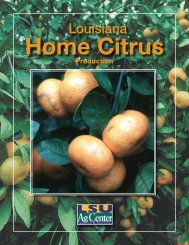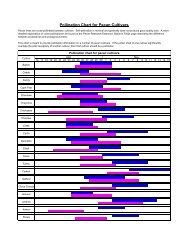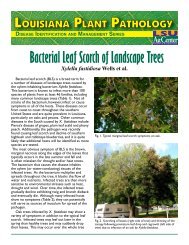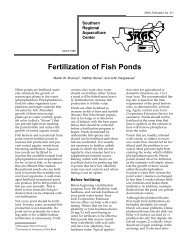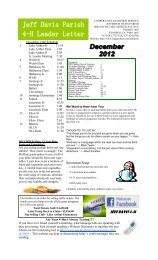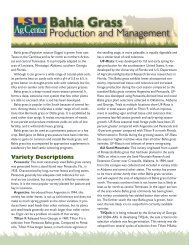Bedding Plants For Louisiana Landscapes - The LSU AgCenter
Bedding Plants For Louisiana Landscapes - The LSU AgCenter
Bedding Plants For Louisiana Landscapes - The LSU AgCenter
Create successful ePaper yourself
Turn your PDF publications into a flip-book with our unique Google optimized e-Paper software.
<strong>Bedding</strong> <strong>Plants</strong><br />
for <strong>Louisiana</strong><br />
<strong>Landscapes</strong>
<strong>Bedding</strong><br />
<strong>Plants</strong> for<br />
<strong>Louisiana</strong><br />
<strong>Landscapes</strong><br />
Introduction<br />
<strong>Bedding</strong> plants are commonly used in residential<br />
and commercial landscapes to provide<br />
color. No other group of plants can so quickly<br />
and economically create a colorful landscape. In<br />
addition to flowers, bedding plants may be grown<br />
for their colorful foliage or interesting forms or<br />
textures. With proper selection, they can be used<br />
to provide color throughout the year.<br />
<strong>Bedding</strong> plants are classified into two groups<br />
based on the temperatures they prefer. Cool-season<br />
bedding plants, such as pansies, dianthus, snapdragons,<br />
stock and calendulas, do best in the cold<br />
to mild temperatures of October through early<br />
May and generally tolerate typical winter freezes<br />
without protection.<br />
Warm-season bedding plants, such as torenia, marigolds, periwinkle and zinnias,<br />
grow and flower best in the warm to hot months of April to October. Since they are<br />
sensitive to freeze damage, they are planted after danger of frost is over.<br />
Most bedding plants are annuals. <strong>The</strong>se short-lived plants grow from seed, bloom<br />
and die within one growing season. <strong>The</strong> transient nature of annuals means that at<br />
the end of their season when they are no longer attractive, annuals are removed and<br />
replaced with new plantings.<br />
Some commonly used warm-season bedding plants are actually tender perennials<br />
grown as annuals. Tender perennials, such as impatiens, periwinkles, blue daze, pentas<br />
and begonias, are generally grouped with the true annuals because in most parts of<br />
the United States they only last one season before dying in winter’s freezes. Tender<br />
perennials grown as annuals have more stamina in the garden than true annuals.<br />
Most true annuals do not make it all the way through our exceptionally long summer<br />
growing season. Tender perennials, on the other hand, bloom from late spring until<br />
cold weather arrives in late November. If not for winter freezes, these plants would<br />
live and bloom for another year, and sometimes do when mild winters occur.<br />
Using Colorful <strong>Bedding</strong> <strong>Plants</strong><br />
<strong>Bedding</strong> plants are the most important group of plants we use for planting flower<br />
beds. Through careful selection, gardeners can grow bedding plants of just about<br />
any color or color combination they can imagine during any time of the year and on<br />
plants that range in height from a few inches to several feet. <strong>The</strong>se versatile plants<br />
can be used in flower beds, mixed borders, pockets among shrubs or ground covers,<br />
containers, hanging baskets and window boxes.<br />
Annual plantings are not low maintenance. Keep in mind that they will need regular<br />
care through the summer when deciding where, how large and how many beds<br />
you will plant.
Since the main function of<br />
bedding plants is to provide<br />
color, some tips on using color<br />
in the landscape are appropriate.<br />
1) <strong>The</strong> human eye is powerfully<br />
drawn to color. Place color<br />
where you want to draw attention.<br />
A flower bed by the trash<br />
cans will not make them look<br />
better, it will just ensure that<br />
everybody notices them.<br />
2) Consider how well the<br />
colors you intend to combine<br />
look together. Generally, it is<br />
more effective to combine a<br />
few complementary or harmonious<br />
colors than to plant many<br />
different colors in the same<br />
bed.<br />
3) Plant beds in masses or<br />
drifts of individual colors.<br />
4) Use colorful beds<br />
around outdoor living areas<br />
where you and your family spend time and can appreciate them.<br />
Preparing <strong>The</strong> Soil<br />
Generally, bedding plants perform best in well-prepared beds with good drainage.<br />
First, remove any weeds or other unwanted plants from the bed. Next, turn the<br />
soil to a depth of about eight inches. Spread a two- to four-inch layer of compost,<br />
rotted leaves, aged manure, composted finely ground pine bark or peat moss over<br />
the bed, and then evenly sprinkle a light application of an all purpose fertilizer. Thoroughly<br />
blend the organic matter and fertilizer into the bed, rake smooth and you’re<br />
ready to plant.<br />
If the drainage is in question, raise the beds about 8 inches above grade by adding<br />
extra organic matter and/or a commercially available soil mix (topsoil or garden soil).<br />
In areas where the native soil is heavy clay and difficult to work with, raised beds<br />
can be created by forming beds 8 to 10 inches high on top of the existing soil using<br />
commercially available topsoil or garden soil.<br />
Seeding And Transplanting<br />
Although purchasing transplants at local nurseries is the most common way to<br />
obtain bedding plants, you may also grow them yourself from seeds. Growing them
from seed allows you the opportunity to grow a wide variety of bedding plants that<br />
are not available at your local nurseries.<br />
Seeds may be started in containers indoors (in sunny windows or under artificial<br />
lights), in hotbeds or cold frames, in greenhouses or outside, if the weather permits.<br />
<strong>The</strong> biggest challenge to planting seeds to grow transplants is providing excellent<br />
growing conditions to produce quality transplants.<br />
You may also plant the seeds directly into the garden bed where they will grow.<br />
This is called direct seeding.<br />
A wide selection of transplants in cell packs, four-inch pots and larger containers<br />
is seasonally available at local nurseries and garden centers. Before you go to<br />
the nursery, look at the size of the area to be planted and try to estimate how many<br />
plants will be needed. On average, bedding plants are spaced about 8 inches apart.<br />
Also think about color schemes and desired heights.<br />
Select stocky transplants with healthy foliage and roots. Avoid transplants that<br />
have lots of faded flowers and yellow leaves.<br />
Choose bedding plants that are appropriate for the time and season when you<br />
are planting. It doesn’t make much sense to plant cool-season bedding plants at the<br />
end of their growing season in April when they will finish in May, for instance.<br />
Consider Growing Conditions<br />
Choose annuals well suited to the growing conditions provided by the location<br />
where they will be planted. Light is especially important. <strong>For</strong> beds that receive at<br />
least six to eight hours of sun, choose sun-loving bedding plants. In beds that receive<br />
about two to four hours of morning sun, choose bedding plants that prefer shady<br />
conditions. Even annuals that like part shade to shady locations, however, will generally<br />
not perform as well in full shade where they receive no direct sun during the day.<br />
Caladiums, planted from tubers or as growing plants, are one of the best choices for<br />
color in full shade.<br />
Planting Transplants<br />
It is important to plant transplants within a week of purchasing them for best<br />
results. Plant transplants so that the top of the root ball is about level with the soil<br />
of the bed. Planting transplants too deeply can cause problems.<br />
<strong>Bedding</strong> plants generally look best and the<br />
beds will fill in better when the rows are staggered.<br />
Lay out the first row of plants spaced<br />
properly. <strong>The</strong> second row is laid behind the<br />
first row at the appropriate spacing from it, but<br />
the plants are placed between the plants of the<br />
first row so that they form triangles with those<br />
plants.<br />
<br />
Example of staggered planting rows.
Once the bed is planted, mulch and thoroughly water the plants in. You may use<br />
a hose-end fertilizer applicator and water them in with a fertilizer solution to get<br />
them off to a good start. Newly planted bedding plants do not have well established<br />
root systems and should be watered thoroughly every few days if the weather is dry<br />
the first few weeks after planting.<br />
Caring <strong>For</strong> <strong>Bedding</strong> <strong>Plants</strong><br />
Flower beds of colorful bedding plants add a lot to the landscape but require a<br />
fair amount of maintenance to stay looking their best. Keeping beds well weeded<br />
is critical. A two-inch layer of mulch will help considerably in keeping weeds from<br />
growing, and using preemergence herbicides (weed preventers) may help in some<br />
situations. But always plan on having to do some hand weeding.<br />
Watering cool-season bedding plants is not as critical during the cool moist<br />
weather of the winter and early spring but is often needed as the weather warms<br />
up in April. Warm-season bedding plants often experience hot, dry weather during<br />
summer, and irrigation will be critical to keeping the plants healthy and attractive.<br />
When watering is needed, it is healthier for the plants to water them deeply and<br />
occasionally (once or twice a week) rather than lightly every day. Since water on the<br />
foliage increases disease problems and water on the flowers can shorten their attractive<br />
life, consider watering your bedding plants with soaker hoses.<br />
Grooming plants to keep the beds looking their best is important because they<br />
attract so much attention. Remove faded flowers and unattractive foliage as needed.<br />
Stake taller growing bedding plants if they begin to lean awkwardly. As bedding<br />
plants finish and become less attractive, remove them promptly, and either mulch the<br />
area or replant it.<br />
Although the best bedding plants are relatively free from major insect and disease<br />
problems, these pests are not uncommon in the flower garden. <strong>The</strong> first step in<br />
proper control is to identify the problem properly. Contact your local <strong>LSU</strong> <strong>AgCenter</strong><br />
Extension office for help with this. Once the pest is properly identified, you can determine<br />
if applying pesticides is needed and get appropriate recommendations from<br />
your local <strong>LSU</strong> <strong>AgCenter</strong> Extension agent or other appropriate sources.
Warm-season <strong>Bedding</strong> <strong>Plants</strong><br />
Name<br />
Amaranthus<br />
Amaranthus tricolor<br />
Ageratum<br />
Ageratum<br />
houstonianum<br />
Balsam, Lady<br />
Slipper<br />
Impatiens balsamina<br />
Blue Daze*<br />
Evolvulus glomeratus<br />
Wax Begonia*<br />
Begonia<br />
semperflorens<br />
Candlestick Plant*<br />
Cassia alata<br />
Castor bean*<br />
Ricinus communis<br />
Celosia (crested)<br />
Celosia cristata<br />
Celosia (plume)<br />
Celosia argentea<br />
Cleome<br />
Cleome hasslerana<br />
Coleus*<br />
Solenostemon<br />
scutellarioides<br />
Cosmos<br />
Cosmos bipinnatus<br />
Cosmos<br />
Cosmos sulphureus<br />
Light<br />
Spacing<br />
Inches<br />
Height<br />
Inches<br />
Use<br />
Comments<br />
Sun 18-24 2-5 feet Background Grown for colorful<br />
foliage<br />
Sun 8 8-12 <strong>Bedding</strong>;<br />
Planters<br />
Sun or<br />
Shade<br />
Sun or<br />
Part<br />
Shade<br />
Part Sun<br />
to Shade<br />
Fuzzy flowers in blue,<br />
pink, white<br />
8-12 12-36 <strong>Bedding</strong> Upright plants with<br />
red, pink, purple or<br />
white flowers<br />
8-12 8-10 <strong>Bedding</strong>;<br />
Containers;<br />
Long<br />
blooming<br />
season<br />
8-12 6-10 <strong>Bedding</strong>;<br />
containers<br />
Sun 36 5-10 feet Background;<br />
Screen<br />
Sun 36 5-10 feet Foliage;<br />
Screen<br />
Sun 24 10-18 <strong>Bedding</strong>;<br />
Cut flower;<br />
Dried<br />
flower<br />
Sun 24 12-36 <strong>Bedding</strong>;<br />
Cut flower;<br />
Dried<br />
flower<br />
Sun to<br />
Part<br />
shade<br />
Sun or<br />
Shade<br />
depending<br />
on type<br />
15 36-48 Cut flower;<br />
Background<br />
12 12-36 Container;<br />
<strong>Bedding</strong>;<br />
Background<br />
Sun 8-12 12-36 Background;<br />
<strong>Bedding</strong>;<br />
Cut flower<br />
Sun 8-12 12-36 <strong>Bedding</strong>;<br />
Background;<br />
Cut flower<br />
Low, mounding plants<br />
with gray backed<br />
foliage; true blue<br />
flowers<br />
Green or bronze<br />
foliage; white, pink or<br />
red flowers<br />
Very tall; spikes of<br />
golden yellow in late<br />
summer<br />
Tall; star shaped<br />
foliage purple or<br />
bronze; seeds<br />
poisonous<br />
Unusual flower heads<br />
in red, orange, yellow<br />
or pink<br />
Plume-shaped flowers<br />
in red, orange, yellow<br />
or pink<br />
Tall, easy to grow;<br />
flowers in purple,<br />
white and pink.<br />
Colorful foliage;<br />
cuttings root easily<br />
Does best during mild<br />
periods in spring and<br />
fall, poorly in summer<br />
and winter; Flowers<br />
pink, burgundy, white<br />
Heat tolerant;<br />
Excellent in summer;<br />
Flowers yellow,<br />
orange, mahogany
Warm-season <strong>Bedding</strong> <strong>Plants</strong><br />
Name<br />
Cypress vine<br />
Ipomoea quamoclit<br />
Dahlia*<br />
Dahlia pinnata<br />
Dusty Miller*<br />
Senecio cineraria<br />
Gomphrena<br />
Gomphrena globosa<br />
Hyacinth bean*<br />
Dolichos lablab<br />
Impatiens*<br />
Impatiens wallerana<br />
Marigold (African)<br />
Tagetes erecta<br />
Marigold (French)<br />
Tagetes patula<br />
Moonvine<br />
Ipomoea alba<br />
Morning glory<br />
Ipomoea purpurea<br />
Moss rose<br />
Portulaca grandiflora<br />
Ornamental Sweet<br />
Potato<br />
Ipomoea batatas<br />
Light<br />
Spacing<br />
Inches<br />
Height<br />
Inches<br />
Use<br />
Sun 12 vine Vine; Screen;<br />
Hummingbird<br />
Sun or<br />
Part<br />
Shade<br />
12-18 12-24 <strong>Bedding</strong>;<br />
container<br />
Sun 8-12 8-15 <strong>Bedding</strong>;<br />
Containers<br />
Sun 6-10 10-24 <strong>Bedding</strong>;<br />
Cut flowers;<br />
Dried<br />
flowers<br />
Sun 12 vine Vine; Screen;<br />
Cut flowers<br />
Shade<br />
to Part<br />
Shade<br />
8-10 8-24 <strong>Bedding</strong>;<br />
Hanging<br />
baskets;<br />
Containers<br />
Sun 12 24-36 Cut flowers;<br />
<strong>Bedding</strong><br />
Sun 8 8-15 <strong>Bedding</strong>,<br />
Containers<br />
Comments<br />
Delicate vine with red<br />
flowers; reseeds<br />
Often do poorly<br />
during summer heat<br />
Excellent silvery<br />
foliage; drought<br />
tolerant<br />
Round flower heads<br />
in shades of purple,<br />
white, pink, red<br />
Purple/lavendar<br />
flowers; Shiny purple<br />
seed pods; Long<br />
bloom season<br />
Reliable color for<br />
shady areas; White,<br />
red, orange, pink,<br />
purple flowers<br />
Yellow, gold or orange<br />
flowers larger than<br />
French<br />
Yellow, gold, orange<br />
or mahogany flowers<br />
smaller than African<br />
Sun 12 vine Vine; Screen White, fragrant<br />
flowers open rapidly<br />
at dusk<br />
Sun 6 vine Vine; Screen Flowers rose, pink,<br />
blue or white close in<br />
late morning<br />
Sun 10 4-6 Baskets;<br />
<strong>Bedding</strong><br />
Sun or<br />
Part<br />
Shade<br />
36 8-10 Cover<br />
large areas;<br />
Ground<br />
cover<br />
Very low growing,<br />
large, attractive<br />
flowers in many<br />
colors. Drought<br />
tolerant.<br />
Colorful foliage dark<br />
purple, chartreuse, or<br />
variegated; returns<br />
each year from<br />
perennial roots
Name<br />
Periwinkle*<br />
Catharanthus rosea<br />
Salvia*<br />
Salvia splendens<br />
Texas Sage*<br />
Salvia coccinea<br />
Garden Verbena<br />
Verbena x hybrida<br />
Common Zinnia<br />
Zinnia elegans<br />
Narrow-leaf Zinnia<br />
Zinnia angustifolia<br />
Profusion Zinnias<br />
Zinnia hybrid<br />
Warm-season <strong>Bedding</strong> <strong>Plants</strong><br />
Light<br />
Spacing<br />
Inches<br />
Height<br />
Inches<br />
Use<br />
Sun 10-12 12-15 <strong>Bedding</strong>;<br />
Containers<br />
Sun or<br />
Part<br />
Shade<br />
Sun or<br />
Part<br />
Shade<br />
<strong>Plants</strong> marked * are tender perennials.<br />
14-21 10-24 Hummingbirds;<br />
<strong>Bedding</strong><br />
12 24 <strong>Bedding</strong>,<br />
hummingbirds<br />
Comments<br />
Bushy plants produce<br />
flowers in white, red,<br />
purple, pink. Disease<br />
problems common.<br />
Drought tolerant.<br />
Flower spikes in red,<br />
white, purple, pink<br />
Red, pink or white<br />
flowers; Long<br />
blooming season<br />
Sun 18 8-18 <strong>Bedding</strong> Perennial verbenas<br />
are much better<br />
bedding plants; This<br />
verbena generally<br />
does not last long<br />
Sun 12 6-36 <strong>Bedding</strong>;<br />
Cut flowers<br />
Sun 8-12 6-8; low,<br />
spreading<br />
growth<br />
habit<br />
<strong>Bedding</strong>;<br />
Hanging<br />
baskets;<br />
Edging<br />
Sun 8 10-12 <strong>Bedding</strong>;<br />
Edging<br />
Outstanding range of<br />
color; Easy to grow<br />
but prone to various<br />
diseases in hot, humid<br />
weather<br />
Outstanding<br />
performance; Long<br />
blooming season;<br />
Flowers in white,<br />
yellow and gold<br />
Hybrid between<br />
Z. elegans and Z.<br />
angustifolia; Highly<br />
recommended for<br />
summer-long blooms<br />
– orange, white, rose,<br />
apricot and red
Name<br />
Alyssum<br />
Lobularia<br />
maritime<br />
Bluebonnets<br />
Lupinus texensis<br />
Cornflower<br />
Centaurea<br />
cyanus<br />
Dusty Miller<br />
Senecio<br />
cineraria<br />
Foxglove<br />
Digitalis<br />
purpurea<br />
Geranium<br />
Pelargonium<br />
hortorum<br />
Larkspur<br />
Consolida<br />
ambigua<br />
Lobelia<br />
Lobelia erinus<br />
Nasturtium<br />
Tropaeolum<br />
majus<br />
Nicotiana,<br />
Flowering<br />
Tobacco<br />
Nicotiana alata<br />
Cool-season <strong>Bedding</strong> <strong>Plants</strong><br />
Light<br />
Sun<br />
or<br />
Shade<br />
Spacing<br />
Inches<br />
Height<br />
Inches<br />
<br />
Cold<br />
Tolerance<br />
Use<br />
6-8 3-6 Hardy Edging;<br />
Containers<br />
Sun 12 12 Hardy Sunny,<br />
dry areas;<br />
Containers<br />
Sun to<br />
Part<br />
Shade<br />
Comments<br />
Low growing<br />
plants; flowers<br />
white, purple, pink<br />
Direct seed in fall;<br />
blue flowers in<br />
spring<br />
8-12 14-30 Hardy <strong>Bedding</strong> Cut flower; Dried<br />
flower. Direct<br />
seed in fall or<br />
transplant in<br />
spring; blue, pink,<br />
white flowers<br />
Sun 8-12 8-15 Hardy <strong>Bedding</strong>;<br />
Containers<br />
Sun to<br />
Shade<br />
Sun to<br />
Part<br />
Shade<br />
12-16 20-36 Hardy <strong>Bedding</strong>;<br />
Background;<br />
Cut<br />
flower<br />
10-12 12-24 Hardy to<br />
20 degrees<br />
<strong>Bedding</strong>;<br />
Containers<br />
Sun 8-10 24-36 Hardy <strong>Bedding</strong>;<br />
Cut flowers<br />
Sun to<br />
Shade<br />
4-6 4-6 Hardy to<br />
mid 20s<br />
Sun 8-15 8-12 Damaged<br />
by temperatures<br />
below 30;<br />
best used<br />
in fall or<br />
spring<br />
Sun to<br />
Shade<br />
Edging;<br />
<strong>Bedding</strong>;<br />
Containers;<br />
Hanging<br />
baskets<br />
Cut flowers;<br />
Edible<br />
flowers<br />
and leaves<br />
12-18 15-30 Hardy <strong>Bedding</strong>;<br />
Cut<br />
flower;<br />
Fragrance;<br />
Hummingbirds<br />
Excellent silvery<br />
foliage; drought<br />
tolerant<br />
Spikes of bellshaped<br />
flowers<br />
in spring or early<br />
summer; Plant<br />
transplants Nov<br />
to March<br />
Round flower<br />
heads in red, pink,<br />
white<br />
Direct seed in<br />
fall; Spikes of pink,<br />
blue, white, rose<br />
flowers in spring.<br />
Not as hardy as<br />
most; Flowers<br />
dark blue, light<br />
blue, pink, rose,<br />
white.<br />
Flowers orange<br />
red, orange,<br />
yellow, gold; Oldfashioned<br />
types<br />
spread; Not hardy<br />
Flowers in white,<br />
pink, dark rose,<br />
lavender, purple
Name<br />
Pansy<br />
Viola x<br />
wittrockiana<br />
Phlox<br />
Phlox<br />
drummondii<br />
Petunia<br />
Petunia hybrida<br />
Pinks, Dianthus<br />
Dianthus<br />
chinensis<br />
Poppy, various<br />
types<br />
Papaver species<br />
Pot Marigold<br />
Calendula<br />
officinalis<br />
Snapdragon<br />
Antirrhinum<br />
majus<br />
Statice<br />
Limonium<br />
sinuatum<br />
Strawflower<br />
Helichrysum<br />
bracteatum<br />
Stock<br />
Matthiola<br />
incana<br />
Cool-season <strong>Bedding</strong> <strong>Plants</strong><br />
Light<br />
Sun to<br />
Part<br />
Shade<br />
Spacing<br />
Inches<br />
Height<br />
Inches<br />
Cold<br />
Tolerance<br />
Use<br />
8-10 4-8 Very Hardy Edging;<br />
<strong>Bedding</strong>;<br />
Containers<br />
Sun 8-10 10-15 Hardy <strong>Bedding</strong>;<br />
Containers<br />
Sun to<br />
Shade<br />
10-12 10-18 Hardy to<br />
20 degrees<br />
<strong>Bedding</strong>;<br />
Planters;<br />
Baskets<br />
Sun 8-12 12-18 Very Hardy <strong>Bedding</strong>;<br />
Cut<br />
flowers;<br />
Fragrance<br />
Sun 8-12 18-30 Hardy Background;<br />
<strong>Bedding</strong>;<br />
Cut flowers<br />
Sun 8-10 10-24 Hardy Cut<br />
flowers;<br />
<strong>Bedding</strong><br />
Sun 8-10 12-36 Very hardy <strong>Bedding</strong>,<br />
Cut flowers<br />
Sun 8-12 12-24 Hardy <strong>Bedding</strong>;<br />
Cut flowers;<br />
Excellent<br />
dried<br />
flower<br />
Sun 8-12 12-24 Hardy <strong>Bedding</strong>;<br />
Cut flowers;<br />
Excellent<br />
dried<br />
flowers<br />
Sun 8-12 15-30 Hardy Cut<br />
flowers;<br />
Fragrance<br />
Comments<br />
Very reliable and<br />
popular; flowers<br />
from fall to spring<br />
in many colors<br />
Spring flowers in<br />
red, purple, white,<br />
pale yellow, pink<br />
Plant in fall in S.<br />
<strong>Louisiana</strong>; flowers<br />
in many colors<br />
Reliable; blooms<br />
fall to early<br />
summer; red, pink,<br />
white, purple<br />
Direct seed in the<br />
fall; Various types<br />
include: Shirley,<br />
Iceland, California,<br />
Peony-flowered<br />
Flowers in shades<br />
of yellow, gold<br />
and orange; petals<br />
are edible.<br />
Bloom poorly in<br />
winter but put on<br />
a grand show in<br />
spring; cut faded<br />
spikes for more<br />
flowers; many<br />
colors<br />
Many colors,<br />
including blue,<br />
purple, pink,<br />
yellow, white<br />
Cut flowers<br />
before fully open<br />
to dry; Many<br />
colors<br />
One of the most<br />
fragrant bedding<br />
plants; flowers in<br />
spikes, burgundy,<br />
pink, white, purple<br />
10
Name<br />
Sweet Pea<br />
Lathyrus<br />
odoratus<br />
Toadflax<br />
Linaria species/<br />
hybrids<br />
Viola, Johnny-<br />
Jump-Up<br />
Viola cornuta;<br />
V. tricolor<br />
Cool-season <strong>Bedding</strong> <strong>Plants</strong><br />
Light<br />
Spacing<br />
Inches<br />
Height<br />
Inches<br />
Cold<br />
Tolerance<br />
Use<br />
Sun 6 Vine Hardy Vine;<br />
Fragrance;<br />
Cut flowers<br />
Sun to<br />
Part<br />
Shade<br />
Sun to<br />
Part<br />
Shade<br />
8 12-24 Hardy <strong>Bedding</strong>;<br />
Background;<br />
Cutting;<br />
Containers<br />
8 6-8 Very Hardy Edging;<br />
<strong>Bedding</strong>;<br />
Containers<br />
Comments<br />
Provide support<br />
for vine; flowers<br />
in shades of red,<br />
blue, purple, white<br />
Direct seed in fall;<br />
blooms in spring<br />
in a wide array of<br />
colors<br />
Very reliable;<br />
blooms from<br />
fall to spring;<br />
similar to pansies<br />
but flowers are<br />
smaller.<br />
11
Visit our Web site:<br />
www.lsuagcenter.com<br />
Authors:<br />
Dan Gill, Associate Professor (Horticulture)<br />
Allen D. Owings, Professor (Horticulture)<br />
School of Plant, Environmental and Soil Sciences<br />
<strong>Louisiana</strong> State University Agricultural Center<br />
William B. Richardson, Chancellor<br />
<strong>Louisiana</strong> Agricultural Experiment Station<br />
David J. Boethel, Vice Chancellor and Director<br />
<strong>Louisiana</strong> Cooperative Extension Service<br />
Paul D. Coreil, Vice Chancellor and Director<br />
Pub. 2747 (10M) 3/07 Rev.<br />
Issued in furtherance of Cooperative Extension work, Acts of Congress of<br />
May 8 and June 30, 1914, in cooperation with the United States Department<br />
of Agriculture. <strong>The</strong> <strong>Louisiana</strong> Cooperative Extension Service provides equal<br />
opportunities in programs and employment.<br />
12




